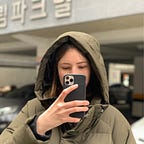We were very interested in exploring the collective, person-to-person aspects of language learning as this was a largely missing from the learning methods last week. Situations hold a lot of rich visual information that is difficult to capture just with visuals: gestures, accents, and audio. So we decided to conduct an in-person body-storming session amongst ourselves to explore the physical aspect of our ideas, trying to bridge the gap between the digital and physical. We were also finding it difficult at this point to focus our ideas for the project, so we hoped this would help us narrow down and start designing.
We had three body-storming sessions:
- One where I learnt French with Tatiana
- One where Kate learnt Arabic with Tatiana
- And one where I practiced Russian with Kate.
Each session lasted 15 minutes, in which time we tried to immerse ourselves in different conversational situations and speak as much as we could in the target language. We provided ourselves with prompt questions in case we got stuck, and couldn’t think of what to say.
We discovered that the conversation prompts were very necessary, as even though we knew each other well we grew shy and embarrassed when asked to say something to the other on the spot. We also found that we all took notes during the session, so that we could anchor down what was being spoken out loud. This also helped the native speaker in the session explain to the learner what things meant by drawing and circling certain things on paper.
Based on these sessions, we were keen to direct the projects focus on placing an emphasis on conversation, and enabling the communication of one’s intentions as a central theme to our FMP.
We starting planning a two-part experience:
- Part 1: A visually contextualised conversation — visualisations appear on surrounding walls as the participants speak.
- Part 2: A personal library — saving and organising all the information from part 1 onto the participants phone to refer to later.
We prototyped it to research the idea through design:
We brought the prototype into class for our weekly feedback session, where we explained our creation: This part of the experience would take place in a white room with a table in the centre, around which two participants would sit. As they speak the things they would say would appear on the wall — words, pictures, doodles they draw out on screens in front of them… These elements would accumulate, becoming reference points on screen to remember what was said, helping to scaffold the conversation.
The experience would be a live data visualisation, which would hopefully help in understanding what the other person was saying. We planned to include props, and other extralinguistic elements that would structure, constrain, and ultimately allow interpretation in normal communication in addition to the images on the walls.
Feedback
Our tutors liked that we were exploring physical ideas, and the weirdness and memorability that can come with it. However, we needed to consider fluidity of use — how can it be used in multiple locations, and is it convenient? We agreed with this, unsure about the inconvenience of the physical experience as this might increase the amount of effort involved in learning — counterproductive to our aims of increasing motivation.
They also warned that the two-part experience might be too much to plan. This is something I was also worried about, so we decided to discuss this as our next plan of action.
>>> For my next post on the project, click here.
